

Proceedings-2005-Watts-and-Bohanon.pdf. Indian Country Diaries . Today's Challenges. In this section of the web site, you will explore in more detail many of the challenges raised in the two documentaries, Indian Country Diaries.
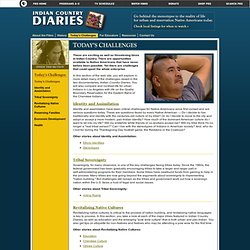
You will also compare and contrast life for urban Indians in Los Angeles with life on the Qualla Boundary Reservation for the Eastern Band of the Cherokee Indians. Identity and Assimilation Identity and assimilation have been critical challenges for Native Americans since first contact and are serious questions today. These are questions faced by every Native American — Do I decide to live traditionally and identify with the centuries-old culture of my tribe? Or, do I decide to move to the city and adopt or accept a more modern, pan-Indian identity? Other stories about Identity and Assimilation: Tribal Sovereignty Sovereignty, for many observers, is one of the key challenges facing tribes today.
Other stories about Tribal Sovereignty: Voting Rights Revitalizing Native Cultures Other stories about Revitalizing Native Cultures: Preserving Families Health. Native American Living Conditions on Reservations - Native American Aid. About 22% of our country’s 5.2 million Native Americans live on tribal lands (2010 U.S.

Census). Living conditions on the reservations have been cited as "comparable to Third World," (May 5 2004, Gallup Independent). It is impossible to succinctly describe the many factors that have contributed to the challenges that Native America faces today, but the following facts about the most pressing issues of economics, health, and housing give a hint of what life is like for many first Americans. Typically, Tribal and Federal governments are the largest employers on the reservations. Many households are overcrowded and earn only social security, disability or veteran's income.
The overall percentage of American Indians living below the federal poverty line is 28.2% (2008, American Indians Census Facts). Chpt5.pdf. Calisphere - California Cultures - 1821-1847: Missions, Ranchos, and the Mexican War for Independence. By: Joshua Paddison Mexican California, sometimes characterized as stagnant or sleepy, was actually a society in dramatic transition.

Politically, the changeover from Spanish to Mexican control in 1821 brought new laws, new administrators, and a shift of power from missionaries to secular governors and powerful ranching families. Demographically, the emigration of Mexican settlers, Russian colonists, American fur trappers and homesteaders, and European entrepreneurs introduced new social complexities. Environmentally, the arrival of European weeds, crops, and animals — especially cattle and horses — transformed California's natural spaces.
Apaches Tell Their Story: The Apaches of Aravaipa Canyon. Conflict with the Spanish When the missionary Father Kino journeyed in 1692 up the San Pedro River (of which Aravaipa Creek is a tributary), violent competition over land and resources existed between the Apache and the Piman descendants of Hohokam civilization – the Sobaipuris and the Tohono O’odham.
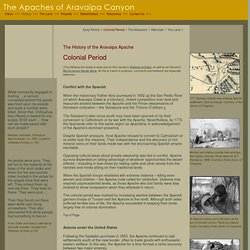
The Sobaipuri’s later move south may have been spurred on by their conversion to Catholicism or by war with the Apache. Tribal History. Before the name "Fort Sill Apache" was applied, the Tribe was what the linguists and anthropologists refer to as the Chiricahua Apache Tribe.
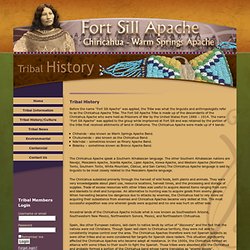
The Fort Sill Apache Tribe is made up of the descendants of the Chiricahua Apache who were held as Prisoners of War by the United States from 1886 – 1914. The name "Fort Sill Apache" was applied to the group while imprisoned at Fort Sill and was retained by the portion of the tribe that received allotments of land in Oklahoma. The Chiricahua Apache were made up of 4 bands: Chihende - also known as Warm Springs Apache Band.Chukunende – also known as the Chiricahua Band.Nde’ndai – sometimes known as Pinery Apache Band.Bidanku – sometimes known as Bronco Apache Band. The Chiricahua Apache speak a Southern Athabascan language. New Mexico Genealogical Society. One of the most enduring legacies of the Spanish and Mexican colonial experience in New Mexico comes from the process by which these governments distributed their land.

Throughout history, governments have given land to citizens as rewards for service, to encourage the colonization of a frontier or promote economic growth. 06_lucero_state.pdf. Land Grants. The Spanish king or his representatives conveyed land to individuals, groups and towns through a system of land grants, or mercedes, in order to promote settlement on the frontier.
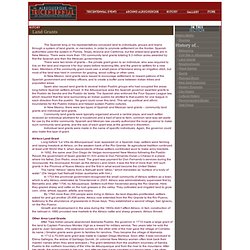
Spanish authorities used the system in , , and , but the oldest land grants are in . There were more than 150 community land grants totaling 9.3 million acres awarded by first the Spanish and then the Mexican governments. There were two kinds of grants – the private grant given to an individual, who was required to live on the land and improve it for four years before receiving title, and the grant to settlers for a new town. Members of the community grant could own a small piece of farmland along an irrigation ditch, but most of the land was held in common for grazing, wood cutting or other uses. In , land grants were issued to encourage settlement, to reward patrons of the Spanish government and military officers, and to create a buffer zone between Indian tribes and populated areas. New Mexico Office of the State Historian : Pueblo of Pecos Grant. Pueblo of Pecos Grant by J.
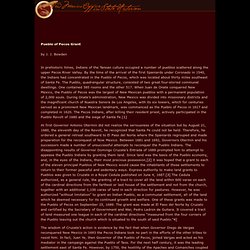
J. Bowden. POJOAQUE PUEBLO. English Pronunciation: "Po-wock-ee or Po-hock-ee" Traditional Name: PO-SUWAE-GEH I-25 north to Santa Fe, 84/285 north of Santa Fe 15 miles.

There is a sign on the highway. t: 505 819 2276 f: 505 819 2299 Pojoaque Pueblo is one of the six Northern Tewa speaking Rio Grande Pueblos.